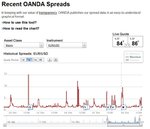Purple Brain
Experienced member
- Messages
- 1,613
- Likes
- 180
Clicked on a LQDMarkets ad banner this morning and was interested to note they offered both fixed and floating spreads. The small print on their 'fixed' spreads said they were fixed 99.79% of the time.
I had a chat with them about what happens during the 0.21% of the time they weren't actually 'fixed' anymore. They said the couldn't predict volatility and couldn't give me any indication what the 'fixed' spreads would be at times of high market volatility, but would be in line with the floating spreads at those times. LOL.
When I asked what their historical maximum spreads were across the majors, they said they didn't have that data. I pointed out that giving me accuracy to two decimal places on how often they were fixed which suggested they should have that sort of data to hand. They were awfully sorry, but they didn't.
I asked the sales guy if they were thinking of selling their company any time soon. He said he didn't know but didn't think so and asked me why I was asking. I told them it was coming up to Christmas and my little nephew wants a cowboy outfit. I would have copied and pasted the transcript, but I lost my connection at this point. No, I really did.
What a bunch of jokers.
I had a chat with them about what happens during the 0.21% of the time they weren't actually 'fixed' anymore. They said the couldn't predict volatility and couldn't give me any indication what the 'fixed' spreads would be at times of high market volatility, but would be in line with the floating spreads at those times. LOL.
When I asked what their historical maximum spreads were across the majors, they said they didn't have that data. I pointed out that giving me accuracy to two decimal places on how often they were fixed which suggested they should have that sort of data to hand. They were awfully sorry, but they didn't.
I asked the sales guy if they were thinking of selling their company any time soon. He said he didn't know but didn't think so and asked me why I was asking. I told them it was coming up to Christmas and my little nephew wants a cowboy outfit. I would have copied and pasted the transcript, but I lost my connection at this point. No, I really did.
What a bunch of jokers.
Last edited by a moderator:

